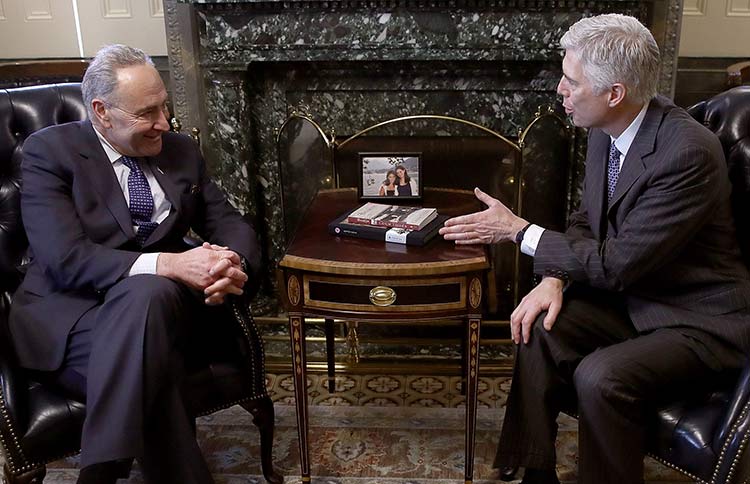Gorsuch Confirmation Hearings: How We Got to the Nuclear Option
WASHINGTON – Senate Democrats blocked Donald Trump’s Supreme Court appointee Neil Gorsuch Thursday, setting up a showdown with Republicans so intent on confirming him that they have threatened to change Senate rules in what’s called the “nuclear option.”
After that vote, Senate Majority Leader Mitch McConnell on Thursday triggered the “nuclear option” to change long-standing rules to confirm Donald Trump’s Supreme Court appointee Neil Gorsuch after Democrats successfully filibustered his nomination.
The Senate’s decision to effectively end its members’ ability to block a high court nomination with a filibuster will have long-term impact by heightening partisanship and politicization of both the Senate and the Supreme Court, lawmakers and experts said.
Keep scrolling for a guide to the steps they are taking, and what is at stake; or click here for today’s full story.

Credit: AP
What you need to know about the filibuster
What is a filibuster?
Named after the Dutch word meaning “pirate,” the term describes how senators can hold the floor for unlimited debate to block legislation or, in this case, a Supreme Court nomination. It is not in the Constitution, but in Senate rules. The minority party uses it to block or shape the majority’s legislative agenda.
Why does the Senate allow filibusters?
It is a distinctive feature of the Senate, allowing its members the right to take to the floor and speak as long as he or she wishes — as dramatized by actor Jimmy Stewart in the 1939 film “Mr. Smith Goes to Washington.” In contrast, the House is run by majority rule, and the leaders of the majority control what happens on the floor.
Why are Democrats threatening a filibuster of Gorsuch?
Schumer said Gorsuch is too conservative and out of the mainstream. Democrats also remain angry that McConnell ignored President Barack Obama’s nominee, Judge Merrick Garland, to hold open the vacancy left by Justice Antonin Scalia, who died in February 2016.
Why are Republicans digging in to confirm Gorsuch?
McConnell said Gorsuch is highly qualified and deserves to be confirmed. McConnell also said the vacancy occurred during a presidential election and voters chose Trump as president, so he gets to pick Scalia’s replacement.
How can a filibuster be stopped?
The majority presents a motion under the cloture rule that allows 30 hours of debate before a vote to end the filibuster. It takes three fifths of the Senate, or 60 votes, to end a filibuster. McConnell made a motion to end the Gorsuch filibuster Tuesday evening, setting the stage for a vote Thursday. Republicans have 52 votes, Democrats 48.
Has a Supreme Court nominee been filibustered before?
In 1968, a bipartisan group threatened a filibuster when President Lyndon Johnson named Abe Fortas as chief justice. A cloture vote failed and Johnson withdrew the nomination. In 2006, some Senate Democrats tried to filibuster the nominee Samuel Alito, but the Senate defeated it in a bipartisan 72-25 vote.
What you need to know about the nuclear option
What is the nuclear option?
It is a change in the Senate rules to lower the threshold of votes needed to end filibusters of Supreme Court nominees from its current 60 to a simple majority of 51. This is done through a series of motions, points of order and votes over the objection of the minority party.
Why is it called a nuclear option?
It is explosive act in what is supposed to be a calm, deliberative body. Many senators say this tactic will create fallout that will stoke acrimony, erode the long-standing senatorial privilege of debate and make the upper chamber increasingly like the majority-rule House. It also means that presidents won’t need a bipartisan majority to approve their Supreme Court nominees, tempting them to select justices even more aligned with their ideology or politics.
Why does McConnell think the nuclear option is needed?
McConnell said he doesn’t seem to have the 60 votes needed to end the filibuster.

Gorsuch met with Sen. Chuck Schumer on Feb. 7, 2017. Getty Images photo.
Has the nuclear option been used before?
In 2013, the Democratic majority acted after the Republican minority filibustered many of Obama’s nominees — changing Senate rules to cut off debate with 51 votes for presidential appointments with one exception: the lifetime appointments to the Supreme Court.
Are Schumer and McConnell seeking a compromise to avoid the nuclear option?
Schumer proposed Wednesday that Trump consult with members of both parties and try to come up with a consensus nominee who could meet the 60-vote threshold. But neither McConnell nor the White House took him up on the offer. McConnell said, “I hope Democrats reevaluate their position before the important vote we’ll take tomorrow.”
Where does the vote now stand?
Schumer said he has 41 Democratic votes, enough to filibuster Gorsuch, though three Democrats said they will vote for him. McConnell said he has the 51 votes necessary to trigger the nuclear option.
Get the latest on the confirmation hearings here.